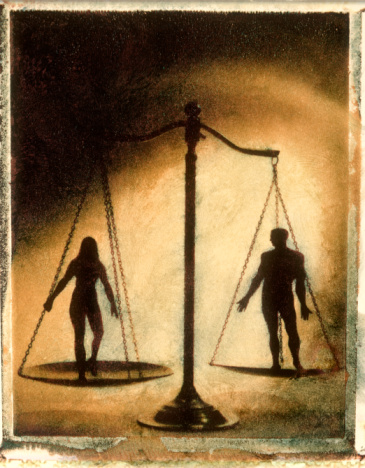For several years in the Middle
Ages even leading up to the Renaissance, women had very few rights and they
basically were viewed as lower class citizens, in comparison to their male
counterparts. Women were thought to be objects of male desire. They were in a
sense domesticated to the home to bear the children and take care of the house.
Women were not to be educated, most likely out of fear that they will surpass
the men. Leading into the renaissance women continued to be viewed in this way
but some were now making themselves known. Women were getting educated and
selling art. But, the downside to this was that they were not supposed to do
anything with this education they were supposed to stay at home.
Women in Europe in the middle ages
had very little rights, many of them were “domesticated” they had to stay at
home and have children and take care of them and the home. They had to be in
subjection to the husband. They had to be this sort of “trophy wife” who was
not only beautiful but a good caregiver to the children and most importantly
the husband. Berger stated in his book, “to be born a woman has been to be
born, within an allotted and confined space, into the keeping of men.” This just
reinforces the proposed role of women in the eyes of men.
Besides not working women were not
supposed to be educated. Since it was basically a man’s world so to speak, this
was all dictated by men. Men were probably or most likely feared women rising
to the top. Literacy was out of the question for women since I guess it was
okay to have an uneducated wife who should only take orders from the husband,
be pretty and bear and take care of the children including the husband. There
was this sort of stigma attached to the role of women and that is what made it
harder for most of them to rebel against that. Not only had this but it made it
more difficult for many women to get recognition for their work especially
female artist.
Around the time of the renaissance many
female artists who wanted to distribute their art they had a difficult time,
since they were women. Women were not even allowed to participate in painting
or sculpturing, that was higher art or that is what was considered art. Men
wanted to set the precedent between what was art and what was craft and
sculpting and painting was art that was for the men and sewing and lace making
that was craft that was for women. (Chadwick 43) So women had to put up with
this ignorant mentality. This did not mean that many women did not find ways
around all of this. There is the example of Angelica Kauffman who was extremely
talented. She was the daughter of a Swiss painter and she was gifted in art and
singing. She sold enough paintings in a year that she was able to afford buying
a house and settle down (Guerrilla Girls 43). But since she was a women if she
married the husband inherited all of that, at least in the middle ages. Rosa
Bonheur is another example she was a cross dresser and she stated that she did
it to promote her work (Guerrilla Girls 48). Dressing as a man helped her sell
more paintings. Edmonia Lewis was also very talented and a great artist she was
sent to court for being accused of poising her roommates and later on also
accused of stealing brushes (Guerilla Girls 50). She was black and a woman so
this must have been why they were even harder on her. Talk about minority. Last
I want to consider Judith Leyster who was also a great painter she had her own school
and she had male students, it was hard enough getting female students and she
had male so this indicated that she was good (Guerilla Girls 40). Through these
movements the role of women was changing. The thought of being in subjection to
the man was changing because women showed what they were capable of doing; through
their works they showed that they were just as capable as their male
counterparts. The renaissance opened the way for this.
In conclusion, women have come a
long way; they challenged what was at the time the norm. The view that women
had to be beautiful and stay at home and clean and cook and take care of the
kids changed drastically. Women were not allowed to participate in certain
forms of art but they found a way. A lot of them were great, even better than
some men. They found ways of selling their art through pure talent, cross
dressing as a man or even selling their art under their husbands name but, they
did it. Even though women have come a long way there is still some prejudice
against women in performing in certain things. It might not be as open as how
it used to be back then but it certainly is still there. I strongly believe
that this mentality or view of women is still embedded in the minds of many
people , and especially many men.
http://iggydonnelly.files.wordpress.com/2009/08/women-power_18.jpg


http://learnsomethingnewtoday.us/wp-content/uploads/2008/04/we-can-do-it.jpg

http://www.flurtsite.com/wp-content/uploads/2013/01/timthumb.php_.jpg

http://twodaymag.com/images/uploads/equal_rights_1.jpg

https://blogger.googleusercontent.com/img/b/R29vZ2xl/AVvXsEj-QtrVwqFmlYsqkJpARS_lMb_B-_OGpLGyfQzyu_jkjPFLxNY9q_1b_8XvRkN0-ysdPZe6E1TRqmLUE8AnaXG2w7SNq4Rgjpue0ILNEb1T0fetXz7Ql-70VyXfyiXPSvgZMirSyDwYK5OX/s1600/men-of-quality-women-rights.jpg


http://www.flurtsite.com/wp-content/uploads/2013/01/timthumb.php_.jpg

http://twodaymag.com/images/uploads/equal_rights_1.jpg

https://blogger.googleusercontent.com/img/b/R29vZ2xl/AVvXsEj-QtrVwqFmlYsqkJpARS_lMb_B-_OGpLGyfQzyu_jkjPFLxNY9q_1b_8XvRkN0-ysdPZe6E1TRqmLUE8AnaXG2w7SNq4Rgjpue0ILNEb1T0fetXz7Ql-70VyXfyiXPSvgZMirSyDwYK5OX/s1600/men-of-quality-women-rights.jpg

Chadwick, Whitney.
Women, Art and Society, Ed.
Thames and Hudson. New
York, New York, 2007.print.
Girls, Guerilla. The
Guerilla Girls’ Bedside Companion to the History of Western Art,
New York: La Guardia Place, 1998.print.
No comments:
Post a Comment